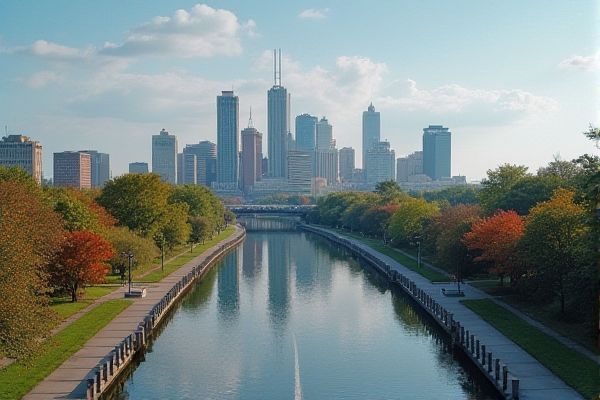
Weather and climate in Wisconsin: Cold, snowy winters. Hot, humid summers. Tornado occurrences. Fluctuating spring temperatures. Wet autumn season. Lake effect weather impacts. Northern lights visibility. Weather-related road conditions. Seasonally strong winds. Regional microclimates exist.
Cold, snowy winters.
Wisconsin's winters are characterized by cold temperatures and significant snowfall, with average temperatures ranging from lows in the teens to highs around the low 30s Fahrenheit. Despite warming trends, winters remain cold and snowy, with areas like Milwaukee and Green Bay experiencing some of the fastest winter warming in the nation. Visit PBS Wisconsin to explore how these changes are impacting the region. Yet, they still maintain substantial snow cover and cold conditions, reflecting the stark reality of climate adaptations in this area.
Hot, humid summers.
Wisconsin experiences hot and humid summers, particularly in July and early August, with temperatures often reaching 90 degrees or higher and heat indices in the 100s. Despite current lower humidity levels due to drought, climate experts predict that Wisconsin will eventually see more extreme summer temperatures and humidity in the future.
Tornado occurrences.
In Wisconsin, the average number of tornadoes per year is 22.6, predominantly comprising EF-0 and EF-1 tornadoes. While these less severe tornadoes occur more frequently, strong tornadoes (EF-2 and above) have notably decreased over the past two decades, yet they continue to account for the majority of injuries and fatalities when they do occur. Tornado activity is particularly higher in southern Wisconsin and areas surrounding Lake Winnebago. For more detailed information and statistical analysis, you can refer to the insights provided by [Weather Stories](https://fox11online.com/weather/weather-stories/strong-tornadoes-have-become-less-frequent-wisconsin-statistics-severe-storm-tornado-alley?src=link). Understanding these patterns is crucial for improving safety measures and preparedness in these regions.
Fluctuating spring temperatures.
Wisconsin's spring weather is characterized by significant fluctuations in temperatures and precipitation. For example, in the spring of 2023, daytime highs were notably warmer than normal, while nighttime lows remained near or slightly above average. Some areas experienced cooler temperatures, and the state saw intense rainfall and snowfall followed by near-record precipitation deficits. This showcase of unpredictable patterns highlights the varied and extreme nature of Wisconsin's spring climate.
Wet autumn season.
Despite a very dry November, Wisconsin's autumn season (September-November 2023) was close to typical in terms of precipitation, thanks to an unusually wet October and near-normal rainfall in September. With the state finishing the season just 0.34 inches (4 percent) below the 1991-2020 average, it provides an insightful perspective on the complexities of climate patterns. For a comprehensive overview, you can explore more on the Wisconsin Climate Summary to understand the factors contributing to these variations.
Lake effect weather impacts.
Lake Effect Snow (LES) in Wisconsin occurs when cold air from Canada passes over the unfrozen, warmer waters of the Great Lakes, leading to intense, narrow bands of snowfall, particularly on the leeward sides of the lakes. This phenomenon is common in late fall and winter, affecting areas like Southeast Wisconsin, where it can cause significant variability in snowfall amounts and visibility, and is influenced by factors such as wind direction, air temperature, and local geography. For more detailed information on this weather pattern, you can visit the National Weather Service website.
Northern lights visibility.
The best time to see the Northern Lights in Wisconsin is from September to March, with the darkest hours of the night (11 pm to 2 am) being the most favorable. Optimal viewing locations include Door County, particularly around Potawatomi State Park and Newport State Park, and areas near Lake Superior, such as Ashland and Bayfield counties, where dark skies and low light pollution enhance visibility. For more details on witnessing this spectacular phenomenon, visit the Northern Lights in Wisconsin web page for an extensive guide on the best viewing times and locations.
Weather-related road conditions.
The Wisconsin Department of Transportation's 511 Wisconsin system offers real-time traffic and weather-related road conditions, including live feeds from over 400 traffic cameras, winter condition reporting, and customizable push notifications for traffic incidents, road closures, and weather advisories. The system leverages data from atmospheric and road weather sensors, snowplows, and the National Weather Service to inform drivers about current road conditions. For more details, visit the 511 Wisconsin webpage where you can access comprehensive travel information.
Seasonally strong winds.
In Wisconsin, seasonally strong winds are notable, particularly during certain periods. For example, Southern Wisconsin can experience very strong winds, with gusts up to 60 mph, especially when deep low-pressure systems track northeastward, creating tight pressure gradients that result in gusty conditions, often leading to minor tree damage and power outages. For more detailed information on this phenomenon, visit the National Weather Service website.
Regional microclimates exist.
Wisconsin's climate varies significantly due to its diverse geography, with regional microclimates influenced by factors such as topography, elevation, and proximity to large bodies of water. The Western Coulees and Ridges Ecological Landscape, for example, features a rugged ridge and coulee topography that creates numerous microhabitats and a high diversity of plants and animals.
